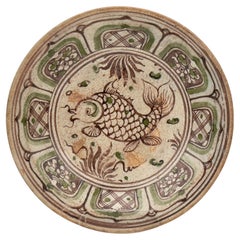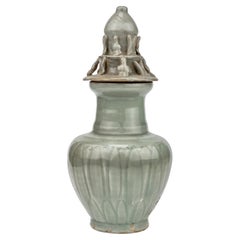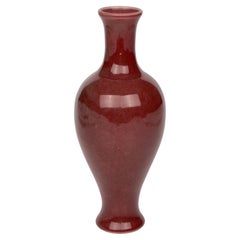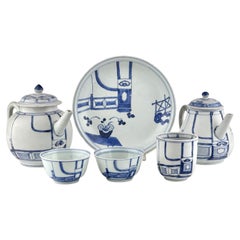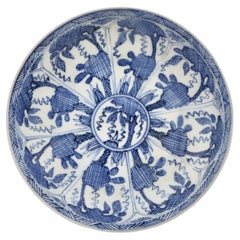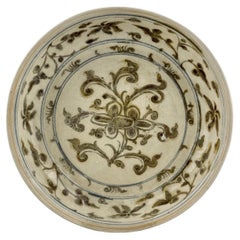South Korea - Antiquities
to
217
251
882
425
251
237
11
3
240
72
44
40
28
251
169
153
82
73
251
251
251
Item Ships From: South Korea
Persian style Annamese stoneware, late 15th century
Located in seoul, KR
Stoneware decorated with Persian-style colors and patterns, and it is highly likely that this Annamese pottery intended for export was produced to meet Middle Eastern demand.
Dates ...
Category
15th Century and Earlier Vietnamese Antique South Korea - Antiquities
Materials
Stoneware
$1,554 Sale Price
40% Off
Carved 'Longquan' Celadon-glazed Funerary vase and cover, Song dynasty
Located in seoul, KR
The vase features a ribbed body, subtly enhancing its graceful contours, and is topped with a uniquely sculpted lid adorned with figurative elements.
Period : Song Dynasty
Type : Ce...
Category
15th Century and Earlier Hong Kong Antique South Korea - Antiquities
Materials
Celadon
$3,995 Sale Price
50% Off
Copper Red Glazed Vase, Late Qing Period, Guangxu Era
Located in seoul, KR
Qing Dynasty, Guangxu mark and of the period. The vase features a classic shape with a long, smooth body and a narrow opening. It is coated with a glossy, crimson glaze, often referr...
Category
19th Century Hong Kong Qing Antique South Korea - Antiquities
Materials
Ceramic, Porcelain
$1,393 Sale Price
30% Off
Rare 'Imari Pavilion' Blue And White Tea Set C 1725, Qing Dynasty, Yongzheng Era
Located in seoul, KR
The "Imari Pavilion pattern" refers to a decoration pattern found on porcelains made during Early Qing Dynasty, influenced by Japanese Imari ware, which was produced in the Arita reg...
Category
18th Century Vietnamese Qing Antique South Korea - Antiquities
Materials
Ceramic
$2,310 Sale Price / set
30% Off
Blue and White Saucer, Qing Dynasty, Kangxi Era, Circa 1690
Located in seoul, KR
It features a complex design with a central circular motif surrounded by eight petal-like sections, each intricately adorned with various botanical and geometric patterns, creating a symmetrical arrangement.
The number 8 in Chinese culture is associated with prosperity and is considered very auspicious. This may reflect the traditional Chinese cosmological concept of the "Bagua," which are eight trigrams used in Taoist philosophy to represent fundamental principles of reality, seen in various aspects of Chinese culture, including the I Ching and Feng Shui.
The central circle with radiating petals is also a representation of perfect geometric harmony, reflecting the balance and unity which are key elements in Chinese aesthetics. The use of symmetry and balance is seen as a way to represent the harmony of the universe.
Period : Qing Dynasty, Kangxi Period
Production Date : 1690-1699
Made in : Jingdezhen
Destination : Netherland
Found/Acquired : Southeast Asia , South China Sea, Vung Tau ship
Size : 12.5cm (Diameter)
Condition : Excellent
Reference : Double checked with reference to the original catalogues
1) Christies Amsterdam 1992 - Vung Tau Cargo / Christies
2) Qing Dynasty Export Blue and White(淸代外销靑花瓷) - Vung Tau Cargo Catalogue / Guangxi Fine Art Publishing House
3) Asian Ceramic Found along Maritime Silk Route / National Maritime Museum of Korea
* Vung Tau Cargo Porcelain...
Category
1690s Vietnamese Qing Antique South Korea - Antiquities
Materials
Ceramic
$594 Sale Price
24% Off
Rare Annamese Brown Dish Circa 15th Century, Le Dynasty
Located in seoul, KR
A rare brown colored stoneware dish with a central floral motif, likely a lotus, which is a recurrent symbol in Asian art representing purity and beauty. The design's fluidity and or...
Category
15th Century and Earlier Vietnamese Antique South Korea - Antiquities
Materials
Stoneware
$2,925 Sale Price
35% Off
The Romance of the Western Chamber Saucer, Qing Dynasty, Yongzheng Era c 1725
Located in seoul, KR
The scene depicted in the porcelain is inspired by "The Romance of the Western Chamber" (西厢记), which is one of the most famous Chinese classical novels and was among the first to be ...
Category
1720s Vietnamese Qing Antique South Korea - Antiquities
Materials
Ceramic
Two Set of Molded Longquan Celadon 'Fu Shou' Vases, Ming Dynasty
Located in seoul, KR
One side of the vase showcases a panel with the Shou character at its center, symbolizing longevity, while the opposite side displays the Fu character, signifying luck. The neck of the vase is adorned with leaves.
Period: Yuan-Ming Dynasty (1271-1644)
Region: Longquan, China
Medium: Celadon
Type: Ewer
Provenance : Acquired in late 1990s from Hongkong
Reference
1) British Museum - Museum number 1931,1118.5
(Type : Closely related)
2) Christies NEW YORK 24–25 MAR 2022 - Important Chinese Ceramics and Works of Art - Lot 1105
(Price realised : 9,450 USD / Type : Related)
3) Sotheby's New York 19 March 2024 - Chinese Art - Lot 172
(Price range : 15,000 USD - 20,000 USD / Type : Related)
* Ming Dynasty Longquan Celadon
Longquan celadon from the Ming Dynasty typically exhibits a more robust and heavier stoneware body compared to its Song Dynasty predecessors. The Ming era saw an evolution in celadon glaze, achieving a wider spectrum of green hues, from olive to bluish-greens. Ming celadons...
Category
15th Century and Earlier Hong Kong Ming Antique South Korea - Antiquities
Materials
Celadon
$3,893 Sale Price
35% Off
Green-Glazed Earthenware Dish Circa 1725, Qing Dynasty, Yongzheng Reign
Located in seoul, KR
It is the rare earthenware among those excavated from the Ca Mau Ship, and it is a green-glaze work that is especially unique. Although it is in very worn condition, it is a valuable...
Category
1720s Vietnamese Qing Antique South Korea - Antiquities
Materials
Earthenware
Ancient Gu Shape Blue And White Vase, Qing Dynasty, Kangxi Era, Circa 1690
Located in seoul, KR
An attractive GU vase hand painted in cobalt blue with typical kangxi flower panels painting separated by lined borders.
Period : Qing Dynasty, Kangxi Period
Production Date : 1690-1699
Made in : Jingdezhen
Destination : Netherland
Found/Acquired : Southeast Asia , South China Sea, Vung Tau ship
Size : 14cm (Height) x 8.5cm (Diameter)
Condition : Excellent
Reference : Double checked with reference to the original catalogues
1) Christies Amsterdam 1992 - Vung Tau Cargo / Christies
2) Qing Dynasty Export Blue and White from Vung Tau Cargo(淸代外销靑花瓷) / Guangxi Fine Art Publishing House
3) Asian Ceramic Found along Maritime Silk Route / National Maritime Museum of Korea
* Vung Tau Cargo Porcelain...
Category
1690s Vietnamese Qing Antique South Korea - Antiquities
Materials
Ceramic
$1,253 Sale Price
30% Off
Heavenly Beings Carved Limestone Stele Fragment, Northern/Eastern Wei Dynasty
Located in seoul, KR
Flying two heavenly beings depicted in the stone. They are celestial beings called an Apsara. While having the same fragment and shape, another work I uploaded exhibits small dots on...
Category
15th Century and Earlier Hong Kong Han Antique South Korea - Antiquities
Materials
Limestone
$6,435 Sale Price
35% Off
Two Annamese Mid-size Lidded Boxes with flower design, 15th century, Le Dynasty
Located in seoul, KR
Vietnamese stoneware cover boxes. These pieces exhibit a relatively vivid blue color compared to similar works from Hoi An hoard. Additionally, they are relatively larger in size amo...
Category
15th Century and Earlier Vietnamese Antique South Korea - Antiquities
Materials
Stoneware
$1,074 Sale Price
40% Off
Amber-Glazed Pottery Figure of Sheep, Tang-Liao Dynasty(7-12th century)
Located in seoul, KR
Naturalistically modelled, standing on a rectangular base with head facing forward, incised details and covered overall in a rich chestnut glaze save for the hooves and base.
Date :...
Category
15th Century and Earlier Hong Kong Tang Antique South Korea - Antiquities
Materials
Pottery
$3,495 Sale Price
50% Off
Famille Rose Teapot Jar, Late Qing Period
Located in seoul, KR
A square Chinese famille rose teapot, Tongzhi mark and of the period
Period: Qing Dynasty
Type: Teapot
Medium: Famille rose, enamel
* Famille Ro...
Category
19th Century Hong Kong Qing Antique South Korea - Antiquities
Materials
Ceramic, Porcelain
Passing Boats And Figure Teabowl And Saucer C 1725, Qing Dynasty Yongzheng Era
Located in seoul, KR
With a medallion of two boats sailing together, passing an island on which a solitary figure stands by or on a bridge, the rim with stone or flower pattern, the reverse glazed cafe-a...
Category
1720s Vietnamese Qing Antique South Korea - Antiquities
Materials
Porcelain
Annamese Stoneware Vase with Underglaze Blue, Hoi An Hoard, Late 15th Century
Located in seoul, KR
At the center of the vase, within a rounded frame, a bird is depicted perched on a small branch. The bird’s feathers and body are finely detailed, while the beak and eyes are rendere...
Category
15th Century and Earlier Vietnamese Antique South Korea - Antiquities
Materials
Stoneware
$1,728 Sale Price
40% Off
Large Rare 'Riverscapes' Pattern Baluster Vase, Qing Dynasty, Kangxi, circa 1690
Located in seoul, KR
Large rare vase painted with petal-shaped panels of riverscapes pattern.
Period : Qing Dynasty, Kangxi Period
Production Date : 1690-1699
Made in : Jingdezhen
Destination : Netherland
Found/Acquired : Southeast Asia , South China Sea, Vung Tau...
Category
1690s Vietnamese Qing Antique South Korea - Antiquities
Materials
Ceramic
$6,493 Sale Price
35% Off
Rare Yue Celadon-Glazed Vessel, Jin dynasty (265-420)
Located in seoul, KR
A Yue celadon vessel from the Jin Dynasty period, notable for its characteristic greenish-glazed pottery which was prominent during this time. The vessel features a globular body wit...
Category
15th Century and Earlier Hong Kong Han Antique South Korea - Antiquities
Materials
Stoneware
$2,535 Sale Price
35% Off
Two Annamese Miniature Covered Boxes with Scenary Motif, 15th century, Le Dynast
Located in seoul, KR
Vietnamese covered boxes with representative scenary designs. Both are made of cream-colored base and blue designs, typical of Annamese pottery. These shared characteristics highligh...
Category
15th Century and Earlier Vietnamese Ming Antique South Korea - Antiquities
Materials
Stoneware
$954 Sale Price / set
40% Off
Chicken Pattern Blue and White Saucer c 1725, Qing Dynasty, Yongzheng Era
Located in seoul, KR
Two roosters are depicted with great precision and skill, surrounded by a landscape featuring rocks and a railing. The motif of roosters and natural elements is traditionally symboli...
Category
1720s Vietnamese Qing Antique South Korea - Antiquities
Materials
Ceramic, Porcelain
Pair of Small Jarlet with arabesque design, Late Ming Era(16-17th century)
Located in seoul, KR
Pair of jarlet from the late Ming dynasty cargo. An identical piece is included on page 145 of the Bin Thuan catalog titled 'The Age of Discovery: Asian Cera...
Category
16th Century Vietnamese Ming Antique South Korea - Antiquities
Materials
Ceramic, Porcelain
Figure of a Horse with traces of white slip, Western Jin-Han Dynasty
Located in seoul, KR
A standing horse, back legs slightly apart and bent, tail erect, wearing a saddle with saddlecloth, and with bridal ornaments on forelock. This horse represents a breed from the Mong...
Category
15th Century and Earlier Hong Kong Han Antique South Korea - Antiquities
Materials
Pottery
$4,550 Sale Price
35% Off
White with Overglaze Enamel Tea Set Circa 1725, Qing Dynasty, Yongzheng Reign
Located in seoul, KR
The wear on its surface is a testament to its age and underwater journey, giving it a unique patina that only time and nature can create. Traces of once-painted nature and chicken il...
Category
1720s Vietnamese Qing Antique South Korea - Antiquities
Materials
Ceramic, Porcelain
Ming Dynasty Two Green Glazed Horses and Riders (15-16th Century)
Located in seoul, KR
Statues of Chinese horse riders, featuring glazes in green, are set on rectangular bases.
Period: Ming Dynasty
Medium: Green-glazed Pottery
Typ...
Category
15th Century and Earlier Hong Kong Ming Antique South Korea - Antiquities
Materials
Pottery
Riverscape Blue and White Teabowl, Circa 1725, Qing Dynasty, Yongzheng Reign.
Located in seoul, KR
The serene landscape and leisure activity of fishing are meticulously captured in cobalt blue on the porcelain's white surface, suggesting the value placed on harmony with the natura...
Category
1720s Vietnamese Qing Antique South Korea - Antiquities
Materials
Ceramic
Three Blue and White Teapots from Ca Mau Ship, C 1725, Qing Dynasty, Yongzheng E
Located in seoul, KR
The pieces are adorned with intricate motifs and scenes that may represent traditional Chinese landscapes, daily life, or historical tales.
Period : Qing Dynasty, Yongzheng Period
P...
Category
1720s Vietnamese Qing Antique South Korea - Antiquities
Materials
Ceramic, Porcelain
$1,112 Sale Price
20% Off
A Sancai-glazed pottery 'Haitai' Pillow, Tang dynasty
Located in seoul, KR
The pillow is intricately decorated with a vibrant pattern, demonstrating the craftsmanship and artistic sensibilities of the period. The Haitai is a creature from Chinese mythology,...
Category
15th Century and Earlier Hong Kong Tang Antique South Korea - Antiquities
Materials
Earthenware, Pottery
$2,950 Sale Price
50% Off
Stem Cup and Stand, Song Dynasty(960~1279)
Located in seoul, KR
Five-lobed cup, featuring a delicate rim, is supported by a short, gently spreading foot. The accompanying stand rises elegantly from a broad base to a plate with an elevated, foliat...
Category
15th Century and Earlier Hong Kong Antique South Korea - Antiquities
Materials
Ceramic
$2,495 Sale Price
50% Off
Rare Cizhou 'Mandarin duck and Reishi mushroom' Painted Pillow, Jin-Song Dynasty
Located in seoul, KR
Mandarin ducks symbolize eternal love and fidelity in East Asian culture, often representing marital harmony as they are believed to mate for life. Reishi mushrooms, known as symbols of longevity and health, are revered in traditional Asian medicine for their association with immortality and have been used for centuries to promote vitality and strengthen the immune system.
The orange glaze is commonly found on Cizhou-type tiger pillows. The attached materials indicate that this tiger pillow is from the same period and shares the same color tone as the one housed in the Baoji Bronzeware Museum, a national museum located in Shaanxi Province. Considering the glaze color, painting style, and shape, it is speculated that this piece was used by the imperial court.
Period : Jin-Song Dynasty(12-13th century)
Type : Pillow
Medium : Cizhou Ware
Size : 28 cm(Width), 30cm(Vertical), 16cm(Height)
Provenance : Acquired in late 1990s from Hongkong
Reference
1) Christies Hongkong 9 OCT 2019 - The Pavilion Sale - Chinese Ceramics and Works of Art Including the Quek Kiok Lee Collection
(Price realised : HKD 225,000 / Type : related)
2) The Baoji Bronzeware Museum, Shaanxi Province - Tiger Cizhou Pillow...
Category
15th Century and Earlier Hong Kong Antique South Korea - Antiquities
Materials
Pottery
$10,680 Sale Price
40% Off
Cizhou Rectangular Pillow with Carved Decoration, Yuan Dynasty
Located in seoul, KR
Cizhou ware is known for its robust forms and freely applied decoration, often featuring a white slip under clear glaze. The pillow is rectangular, with a slightly curved top surface to accommodate the head of the sleeper. The decoration on this pillow features an incised design, delineated with fine lines to create a clear and simplistic representation. The motif includes floral elements, likely peony or chrysanthemum, and foliage, which were popular during the Song and Yuan periods. The carving is subtle yet skillful, showing the artistry and aesthetic preferences of the era.
Period : Yuan Dynasty, 13th-14th Century
Type : Pillow
Medium : Cizhou Ware
Provenance : Acquired in late 1990s from Hongkong
Reference :
1) Datong Museum - Cizhou Pillow...
Category
15th Century and Earlier Hong Kong Antique South Korea - Antiquities
Materials
Pottery, Stoneware
$2,535 Sale Price
35% Off
Three Small White-glazed Circular Boxes and Coveres, Qing Dynasty, Kangxi Era, C
Located in seoul, KR
Three White glazed boxes from the Qing dynasty Vung Tau cargo. Identical pieces are included on page 459 of the Vung Tau catalog titled 'Christies Amste...
Category
1690s Vietnamese Qing Antique South Korea - Antiquities
Materials
Ceramic, Porcelain
$752 Sale Price
20% Off
Rare Yue Celadon Chicken-Head Ewer, Jin-Southern Dynasty
Located in seoul, KR
Chicken-head celadon is among the most distinct and emblematic piece from the dynamic yet innovative era spanning from the Han (206 BC - AD 220) to the Tang (618-907) dynasties. Thei...
Category
15th Century and Earlier Chinese Han Antique South Korea - Antiquities
Materials
Celadon
$3,495 Sale Price
50% Off
Two Annamese Miniature Covered Boxes with Flower, 15th century, Le Dynasty
Located in seoul, KR
Vietnamese covered boxes with star like flower designs. Both are made of cream-colored base and blue designs, typical of Annamese stoneware.
Dates : 15th century Le Dynasty
Region :...
Category
15th Century and Earlier Vietnamese Antique South Korea - Antiquities
Materials
Stoneware
$1,260 Sale Price / set
30% Off
Swatow Lidded Boxes in the shape of Waves and Flowers, Late Ming Era(16-17th c)
Located in seoul, KR
Small green-glazed boxes from the late Ming dynasty cargo. Identical pieces are included on page 142, 143 of the Bin Thuan catalog titled 'The Age of Discove...
Category
16th Century Vietnamese Ming Antique South Korea - Antiquities
Materials
Ceramic, Pottery
Changsha ewer, Tang Dynasty(618-907)
Located in seoul, KR
Changsha Ware has distinct and recognizable designs and motifs. Painted designs often depict flowers, vines, clouds and mountain landscapes. Some painting is simply splotches of colo...
Category
15th Century and Earlier Hong Kong Tang Antique South Korea - Antiquities
Materials
Stoneware
$3,196 Sale Price
60% Off
An Annamese stoneware with cobalt blue, Hoi An Hoard, Late 15th century
Located in seoul, KR
At the center of the vase, a bird is depicted with clean yet detailed lines, capturing the moment mid-flight with a sense of dynamic energy. The artist skillfully conveys the bird’s vitality with minimal strokes, creating the impression that it could soar into the sky at any moment.
Though there are no explicit branches or leaves, the flowing curves of the background subtly connect the bird with the natural world. The simplicity of the lines creates a harmonious relationship between the bird and its environment, reflecting the artist’s ability to evoke nature without relying on intricate details.
The neck of the vase is adorned with elegant plant motifs, where stems and leaves stretch upward, complementing the overall shape of the vase. These motifs, while simple, add sophistication and enhance the vase’s graceful form.
At the base, repeating geometric patterns contribute to the sense of balance and stability. These patterns not only ground the piece but also serve as decorative elements, completing the vase’s aesthetic unity.
Dates : 15th century Le Dynasty
Region : North Annam, Vietnam
Type : Yuhuchun Vase
Found/Acquired : Southeast Asia , South China Sea, Hoi An Ship
Reference :
1) Seattle Art Museum - Gift of Mary and Cheney Cowles, 2000.125.
2) Butterfield Treasures Hoi An Hoard Auction Catalogs / San Francisco Butterfields 2000
3) Asian art museum, San Francisco
* Vietnamese trade ceramic...
Category
15th Century and Earlier Vietnamese Ming Antique South Korea - Antiquities
Materials
Stoneware
$1,943 Sale Price
35% Off
Cizhou carved bean-shaped pillow, Song-Jin Dynasty, 11th-12th century
Located in seoul, KR
Crafted from fine clay, the pillow's surface boasts a sophisticated carved design featuring a floral motif that is both symmetrical and organic. The interplay of the earthy tones and...
Category
15th Century and Earlier Hong Kong Chinoiserie Antique South Korea - Antiquities
Materials
Stoneware
$2,535 Sale Price
35% Off
A Rare Yue Celadon-Glazed Figural Vessel, Western Jin dynasty (265-420)
Located in seoul, KR
This vessel is well-modeled as a recumbent winged lion with detailed decorative elements. It features a grimacing face with large protruberant eyes under heavy brows and a gaping mouth, which forms a large aperture. The piece has a tail that arches to form a loop handle, and the wings are incised on the sides. The whole piece is finished with a thin olive-green glaze.
This kind of figural vessel dates back to at least the Western Han dynasty, with the design fully developed in the Yue kilns of Zhejiang province during the 3rd and 4th centuries. Such zoomorphic forms became popular among the literati and were transformed into various functional objects like wine ewers and water pots.
There is a pair, and you can check it in the uploaded list. If you would like to purchase two in pairs, please leave a message.
Period : Western Jin Dynasty (266 - 316 AD)
Type : Figural vessel
Medium : Yue celadon(Stoneware)
Provenance : The piece was acquired in Hong Kong in late 1990s.
Reference :
1) Sotheby's New York 17 March 2015 - Chinese Art Through The Eye Of Sakamoto Gorō – Ceramics Lot 33
(Price Range : 15,000 USD-20,000 USD / Type : Highly related)
2) Sotheby's London 17 May 2023 - A Journey Through China's History. The Dr Wou Kiuan Collection Online. Part I - Lot 30
(Price realised : 13,970 GBP / Type : Closely related)
3) Ethnological Museum, Berlin, Germany - Pouring vessel in animal shape, China, Yue kilns, Zhejiang province, late Western or early Eastern Jin dynasty, 4th century
4) Sotheby's London 16 May 2018 - Important Chinese Art Lot 68
(Price realised : 50,000 GBP / Type : Closely related)
5) The MET - Accession Number: 1985.207 - Vessel in the Shape of a Tiger (Huzi)
(Type : Closely related)
* Yue Celadon
Yue celadon, also known as Yue ware, is a type of Chinese pottery with a celadon glaze, originating from the eastern Han dynasty in the Zhejiang province. The name 'Yue' comes from the Yue kilns which were among the earliest to develop the celadon technique. Yue ware is known for its jade-like glaze, which can range in color from bluish-green to olive green.
Yue celadon was highly regarded during its time and was the first Chinese ware...
Category
15th Century and Earlier Hong Kong Chinese Export Antique South Korea - Antiquities
Materials
Celadon
$9,950 Sale Price
50% Off
Blue and White Flower Saucer c. 1725, Qing Dynasty, Yongzheng Era
Located in seoul, KR
The central floral motif, possibly representing peonies or another culturally significant flora, is surrounded by intricate patterns and border designs typical of the period. Pieces ...
Category
1720s Vietnamese Chinoiserie Antique South Korea - Antiquities
Materials
Ceramic
'Passing Boat And Bridge' Blue And White Saucer C 1725, Qing Dynasty, Yongzheng
Located in seoul, KR
With a medallion of two boats sailing together, passing an island on which a solitary figure stands by or on a bridge, the rim with a narrow heringbone pattern, the reverse glazed ca...
Category
Late 17th Century Vietnamese Qing Antique South Korea - Antiquities
Materials
Ceramic, Porcelain
White Ware Covered Jar, Song Dynasty
Located in seoul, KR
It features a smooth, rounded body with a soft white glaze that highlights its elegant, minimalist design. The lid is carefully crafted to fit securely, while the jar’s simple form i...
Category
15th Century and Earlier Hong Kong Antique South Korea - Antiquities
Materials
Pottery
$1,673 Sale Price
30% Off
Mid-size Octagonal Saucer, Qing Dynasty, Kangxi era, circa 1690.
Located in seoul, KR
The design features a central medallion surrounded by eight panels, each intricately painted with traditional Chinese botanical and floral motifs.
The number 8 in Chinese culture is associated with prosperity and is considered very auspicious. This may reflect the traditional Chinese cosmological concept of the "Bagua," which are eight trigrams used in Taoist philosophy to represent fundamental principles of reality, seen in various aspects of Chinese culture, including the I Ching and Feng Shui.
The central circle with radiating petals is also a representation of perfect geometric harmony, reflecting the balance and unity which are key elements in Chinese aesthetics. The use of symmetry and balance is seen as a way to represent the harmony of the universe.
Period : Qing Dynasty, Kangxi Period
Production Date : 1690-1699
Made in : Jingdezhen
Destination : Netherland
Found/Acquired : Southeast Asia , South China Sea, Vung Tau...
Category
1690s Vietnamese Qing Antique South Korea - Antiquities
Materials
Ceramic
Very Rare Ewer of a Seated Monkey, C 1725, Qing Dynasty, Yongzheng Era
Located in seoul, KR
This statue is a representative piece excavated from the Ca Mau shipwreck. It is featured on the cover of the collection book by Dr. Zelnik. Ewer and cover in the form of a seated mo...
Category
1720s Vietnamese Qing Antique South Korea - Antiquities
Materials
Ceramic
Famille Rose Hongxian Marked Sleeve Vase With Flowers, Republic Period
Located in seoul, KR
A stunning 20th-century Chinese Famille Rose vase, also known as a hatstand, from the Republic period, is adorned with a detailed Hongxian mark on the bottom. This vase features exqu...
Category
20th Century Hong Kong Qing South Korea - Antiquities
Materials
Ceramic, Porcelain
Brown Glazed Small Jar with Two Dragons and a Fish, Song-Yuan Dynasty
Located in seoul, KR
The glaze blends harmoniously with the color of the clay, giving a natural, earthy feel. This piece features intricate carvings of two dragon presumably pursuing a sacred jewel called "Yeouiju" and a fish. The glaze drips and irregular streaks of brown-glazed pottery from that period are distinctive aesthetic elements of Song-Yuan Dynasty brown glazed ceramics, with glaze colors ranging from deep chocolate to light amber or honey tones.
Date : Song-Yuan Dynasty(960~1368)
Type : Olive-Brown-glazed pottery
Provenance : Acquired in late 1990s from Hongkong
Reference :
1) Bonhams London 13 May 2024 - The John E. Bodie OBE (1930-2023) Collection of Chinese Art - Lot 12
(Price realised : 2,432 GBP / Type : Closely related)
2) Christies 25 Mar 2015 - The Collection of Robert Hatfield Ellsworth...
Category
15th Century and Earlier Hong Kong Tang Antique South Korea - Antiquities
Materials
Pottery
$2,382 Sale Price
40% Off
A Cizhou Yuhuchunping, Yuan Dynasty
Located in seoul, KR
This piece has a flared neck and a globular body, typical of the forms seen in Cizhou ware. The body is decorated with freely drawn floral motifs and abstract patterns, which may inc...
Category
15th Century and Earlier Hong Kong Chinese Export Antique South Korea - Antiquities
Materials
Stoneware
$7,960 Sale Price
60% Off
Famille Rose/Verte Ewer, Qing Dynasty
Located in seoul, KR
Beautiful flowers and scenary painted familie rose/verte ceramic ewer from Qing dynasty. Excavated from cargo underwater.
This piece is from the early Qing dynasty, and it is not cl...
Category
17th Century Vietnamese Qing Antique South Korea - Antiquities
Materials
Ceramic
$838 Sale Price
35% Off
Celestial being(Apsara) Stone Statue, Northern Wei-Tang Dynasty
Located in seoul, KR
This statue appears to be a stone sculpture of an apsara, a celestial nymph from Buddhist and Hindu traditions. Despite its fragmentary state, the sculpture conveys grace and movement. The apsara is captured in a dynamic pose, perhaps once part of a larger tableau, playing a flute-like instrument. The facial features are serene yet expressive, with faint traces of pigmentation hinting at the sculpture's original polychromy. The black stand was made in Hong Kong at the time of the acquisition.
Date : Northern Wei...
Category
15th Century and Earlier Hong Kong Tang Antique South Korea - Antiquities
Materials
Stone, Limestone
$4,450 Sale Price
50% Off
Rare Yue Celadon-Glazed Figural Vessel, Western Jin dynasty (265-420)
Located in seoul, KR
This vessel is well-modeled as a recumbent winged lion with detailed decorative elements. It features a grimacing face with large protruberant eyes under heavy brows and a gaping mou...
Category
15th Century and Earlier Hong Kong Han Antique South Korea - Antiquities
Materials
Celadon
$7,950 Sale Price
50% Off
Annamese Stoneware Miniature Vase and Jar, Hoi An Hoard, Late 15th C, Le Dynasty
Located in seoul, KR
These ceramics feature finely detailed depictions of birds and cloud motifs using underglaze blue, showcasing an elegant and refined design. The vase portrays a bird in mid-flight, w...
Category
15th Century and Earlier Vietnamese Ming Antique South Korea - Antiquities
Materials
Stoneware
$995 Sale Price / set
50% Off
Tripod in the shape of a bronze vessel li, Zhou or Shang dynasty
Located in seoul, KR
The tri-lobed shape and combed ridges of this cooking pot increased heating efficiency by maximizing the vessel’s surface area. The shape of a bronze vessel li, with the body rising out of three hollow pointed legs to a wide moiuth with splayed-out rim. The exterior is covered with cord impressed pattern. The surface shows signs of oxidation from being buried in the soil for a long time.
Period: Zhou or Shang dynasty circa 1000 B.C.E.
Medium : Grey earthenware with impressed decoration
Type : Tripod vessel
Size : 29cm (Height) x 35cm(Diameter)
Condition : Good
Provenance : Acquired in late 1990s from Hongkong
Reference :
1) V&A Museum - ACCESSION NUMBER C.87-1954
2) Smithsonian National Museum of Asian Art - ACCESSION NUMBER F1984.13
3) The University of Chicago - OBJECT NUMBER 1989.1
4) The MET - Accession Number: 1972.275.5
5) Kyoto National Museum - Three-footed Earthenware Vessel
* Shang Dynasty Pottery (1600-1046 BCE)
The Shang dynasty, known for its significant advancements in bronze casting, also produced notable pottery. Shang pottery is characterized by its practical use and simple designs, reflecting the utilitarian needs of the society. The pottery from this period includes both coarse wares used for everyday purposes and fine, high-quality ceramics used in ritualistic contexts. Common forms include jars, bowls, and cups, often with a dark, burnished surface. One distinctive feature of Shang pottery is the use of gray clay, and many pieces display clear signs of oxidation, giving them a unique, mottled appearance. The decorations were typically incised or stamped, featuring geometric patterns, zoomorphic designs, and motifs that are also seen in Shang bronze...
Category
15th Century and Earlier Hong Kong Antique South Korea - Antiquities
Materials
Pottery
$3,495 Sale Price
50% Off
Green-glazed model of a Haitai, Han dynasty
Located in seoul, KR
This Han Dynasty green-glazed Haitai sculpture, though worn over time, retains its dynamic form.
Period : Han Dynasty (206 BC - 220 AD)
Medium : Earthenware with Green glaze
Provena...
Category
15th Century and Earlier Hong Kong Han Antique South Korea - Antiquities
Materials
Pottery
$2,250 Sale Price
25% Off
Black-glazed Lion Pillow, Northern Song-Jin Dynasty
Located in seoul, KR
Black-glazed ceramic pillow, frequently-produced during the Jin dynasty. Similar piece can be found in the Guanfu Museum, where there are black-glazed pillows...
Category
15th Century and Earlier Hong Kong Antique South Korea - Antiquities
Materials
Ceramic
$3,495 Sale Price
50% Off
White with Overglaze Enamel Tea Set Circa 1725, Qing Dynasty, Yongzheng Reign
Located in seoul, KR
The wear on its surface is a testament to its age and underwater journey, giving it a unique patina that only time and nature can create. The overglaze enamel decoration that adorns ...
Category
1720s Vietnamese Qing Antique South Korea - Antiquities
Materials
Ceramic, Porcelain
Rare Lion Figurine Pillow, Tang Dynasty(618-907)
Located in seoul, KR
To meet overseas demand, shapes of Changsha wares were also greatly influenced by exotic elements from beyond China. For example, lion-shaped artifacts were found, as were a number o...
Category
15th Century and Earlier Hong Kong Tang Antique South Korea - Antiquities
Materials
Stoneware
$9,743 Sale Price
35% Off
Amber-Glazed Pottery Figure of Sacred Bull, Tang-Liao Dynasty (7-12th Century)
Located in seoul, KR
Naturalistically modelled, standing on a rectangular base with head facing forward and short tail curled to one side, incised details and covered overall in a rich chestnut glaze sav...
Category
15th Century and Earlier Hong Kong Tang Antique South Korea - Antiquities
Materials
Pottery
$4,537 Sale Price
35% Off
Three Annamese Stoneware Miniature Jarlets, 15th Century, Le Dynasty
Located in seoul, KR
In the shape of a tower(Chess) with blue decoration on the body, chocolate ring on the base.
Dates : 15th century Le Dynasty
Region : North Annam(Viet...
Category
15th Century and Earlier Vietnamese Antique South Korea - Antiquities
Materials
Stoneware
$1,794 Sale Price / set
40% Off
Amber-Glazed Pottery Figure Of Sacred Bull, Tang-Liao Dynasty (7-12th Century)
Located in seoul, KR
Naturalistically modelled, standing on a rectangular base with head facing forward and short tail curled to one side, incised details and covered overall in a rich chestnut glaze sav...
Category
15th Century and Earlier Hong Kong Tang Antique South Korea - Antiquities
Materials
Pottery
$3,990 Sale Price
50% Off
Green Glazed Red Pottery Figure of Dog, Han dynasty (206 BC-220 AD)
Located in seoul, KR
The dog faces forward, with clearly defined eyes that stand out. Its ears are slightly curled, giving the impression of a relaxed, natural stance. The collar around its neck, connect...
Category
15th Century and Earlier Hong Kong Han Antique South Korea - Antiquities
Materials
Pottery
$2,242 Sale Price
25% Off
Guardian Haitai Lion Pottery Figure, Northern Wei-Tang Dynasties
Located in seoul, KR
This figure represent a guardian haitai. The style of the figurine, with its facial features and remnants of paint, suggests it could be a part of funerary art, which was common in Chinese culture during these periods.
Date : Northern Wei...
Category
15th Century and Earlier Hong Kong Tang Antique South Korea - Antiquities
Materials
Pottery, Stoneware
$1,944 Sale Price
34% Off
Recently Viewed
View AllMore Ways To Browse
Kimekomi Dolls
Luristan Bronze
Luristan Dagger
Monkey Gong
Pegu Bronze
Ruo Shen
Wheat Thrasher
11th Century Vishnu Stone Statue
Antique Cast Iron Hibachi
Dinosaur Statue
Han Dynasty Stick Man
Leather Rice Paddy Shoes
Vintage Bone China Flowers
Vintage Bull Figurine
Vintage Cast Iron Fire Basket
Vintage Ceramic Pig
Vintage Cowboy Saddle
Vintage Dragon Figurine
